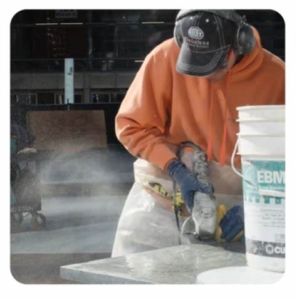Lung Disease in Countertop Fabricators: 4 Primary Risk Factors of Deadly Disease
Silicosis associated with inhalation of respirable crystalline silica among engineered stone countertop fabrication workers is an emerging health concern. Silicosis, a debilitating lung disease caused by exposure to respirable crystalline silica (RCS), is a severe concern for countertop fabricators.
Silicosis is a lung disease caused by the inhalation of crystalline silica dust, which is produced during the cutting, grinding, or polishing of materials like granite and quartz. The fine silica particles are so small that they can easily penetrate deep into the lungs, causing inflammation and scarring. Silicosis develops over time, often silently, with symptoms not appearing until years after exposure. For countertop fabricators, the risk of silicosis is a growing concern, as the demand for stone countertops continues to rise.
Countertop fabricators are particularly vulnerable to silicosis due to the nature of their work. They are routinely exposed to high levels of RCS while cutting and shaping stone slabs. The primary risk factors include:
Countertop Fabricator’s and Employer’s Lack of Awareness: Many fabricators are unaware of the risks associated with silica exposure and may not take adequate precautions. Silicosis is notorious for its delayed onset of symptoms, which can take years to manifest. This makes it difficult for countertop fabricators to connect their health issues to workplace exposure. Many fabricators may not even realize the risks they face, leading to underreporting of illnesses and limited data on the true extent of the problem.
Inadequate Ventilation: Without adequate ventilation, workers are exposed to elevated levels of airborne silica dust, which significantly increases their risk of developing silicosis, as well as other respiratory and lung-related diseases. OSHA (Occupational Safety and Health Administration) regulations require employers to provide a safe working environment. Inadequate ventilation can result in compliance issues and potential legal consequences.
Prolonged Exposure Leads to Serious Lung Disease: Countertop fabrication often involves long hours of continuous work, leading to prolonged exposure to silica dust. Prolonged exposure to silica dust presents significant health risks, primarily due to its ability to enter the respiratory system and cause serious health problems.
Lack of Personal Protective Equipment (PPE): Failure to use appropriate PPE, such as respirators and dust masks, can exacerbate the risk of inhalation. Workers should wear appropriate respiratory protection, such as N95 respirators or higher-grade respirators designed to filter out fine silica particles. Fit testing and proper training on respirator use are essential.
Silicosis is a hidden threat that countertop fabricators face daily, often without realizing it. The lack of awareness about this potentially life-threatening disease is a significant concern for the industry. By increasing education and training, enforcing safety measures, providing regular health screenings, and advocating for support systems, we can begin to address this issue and ensure that the health and well-being of countertop fabricators are safeguarded, alongside their remarkable craftsmanship. It’s time to make the invisible threat of silicosis visible and protect those who create the beauty in our homes.
For more information about respirable crystalline silica in the workplace, go to the NIOSH Crystalline Silica web page or the CDC Silicosis in the Workplace page.
If you’ve been diagnosed with silicosis—sometimes also referred to pulmonary fibrosis or diagnosed in connection with pneumoconiosis or interstitial lung disease (ILD)—an attorney at Carter Law Group can protect your legal rights and fight to get you and your family the compensation you deserve.
Please visit our Education and Resources page for additional information on how silica causes disease, your silicosis diagnosis, government regulations related to silica and silica exposure, and other information and educational tools related to your injuries, your potential lawsuit, and how Carter Law Group can help you.




